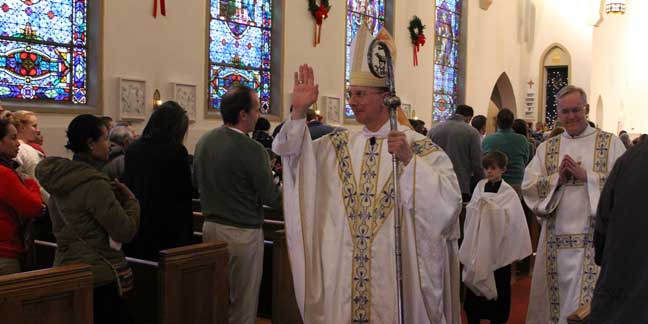 Bishop Jugis announces Marian theme for Eucharistic Congress on Solemnity of Mary, Mother of God Jan. 1
Bishop Jugis announces Marian theme for Eucharistic Congress on Solemnity of Mary, Mother of God Jan. 1
CHARLOTTE — The new year brings with it some special Marian anniversaries in the Church, Bishop Peter Jugis noted in his homily at Mass on Jan. 1, the Solemnity of Mary, Mother of God.
“We begin this New Year 2017 as we begin every new year – continuing the Christmas season and honoring Mary, the Mother of God on the Octave of Christmas,” he said during Mass celebrated at St. Patrick Cathedral.
But, Bishop Jugis noted, “This New Year is special because in 2017, we are marking several important Marian anniversaries. So it seems appropriate that on this first day, drawing attention to our Blessed Mother Mary, we should make note of the special anniversaries coming up in 2017.”
This year marks the 100th anniversary of Our Lady’s apparitions at Fatima, Portugal, in 1917. This year also marks the 100th anniversary of St. Maximilian Kolbe establishing the Militia of Mary Immaculate.
“We know the sufferings, of course, that Maximilian Kolbe underwent during the occupation of Poland,” Bishop Jugis said. “That movement he established as a young priest in 1917, the Militia of Mary Immaculate, was a program of spiritual renewal through dedication and consecration to the Blessed Virgin Mary. Since then, it has grown into a worldwide movement of spiritual renewal.”
Because of these two Marian anniversaries, he continued, some have suggested that 2017 should be called “The Year of the Immaculate Heart of Mary.”
“There will be big festivities going on this year in Fatima, Portugal,” he said. “At Fatima, Our Lady reveals her Immaculate Heart to us. She says, ‘In the end my Immaculate Heart will triumph.’ We might ask the question: Triumph over what? And, of course, we know the answer: Triumph over all evil.”
Mary’s purity, sinlessness and holiness triumphs over all evil as we see in her Immaculate Conception, he said. God allowed her, at the moment of her conception, to triumph over original sin, crushing the head of the serpent. “In the end she says, ‘My Immaculate Heart will triumph,’ she assures us.”
Bishop Jugis shared that there is another interesting anniversary this year. Thirty years ago on Jan. 1, 1987, St. John Paul II announced a Marian holy year for the Church, to run mid-1987 through mid-1988. To celebrate that Marian holy year, the pope wrote an encyclical about Mary, “Redemptoris Mater.”
“To help us celebrate these special anniversaries this year, we chose a line from Mary’s Magnificat as the theme of this year’s Eucharistic Congress: ‘My soul proclaims the greatness of the Lord,’" Bishop Jugis announced.
“Those words come from the account of the Blessed Mother’s visit to her cousin Elizabeth, the visitation. At her visitation to her cousin Elizabeth, Our Lady, with the Infant Jesus in her womb, is filled with joy and she praises God: ‘My soul proclaims the greatness of the Lord. My soul magnifies the Lord.’”
Her words are fittingly echoed in the theme of the 2017 Eucharistic Congress, he continued.
"When we are nourished with the Body and Blood of Christ in Holy Communion and we receive Christ within us, we receive abundant graces, abundant holiness, so that our lives become a living proclamation of the Lord’s greatness, His goodness and His holiness.”
“The Eucharist manifests itself by our living proclamation of God’s goodness and greatness in our lives,” he said.
The first day of the Eucharistic Congress in Charlotte is also a Marian holy day: the feast of the birth of Mary, Sept. 8.
“We begin the Year of Our Lord 2017 begging the maternal intercession and protection of our Blessed Mother. What a great way to begin a new year – asking the Holy Mother of God to protect us and to intercede for us,” Bishop Jugis said.
At the conclusion of his homily, he drew from a beautiful prayer in the Liturgy of the Hours, from the Common of the Blessed Virgin Mary. Bishop Jugis shared that he believes we can all use this verse in living our faith this year under the watchful eye of Our Blessed Mother: “O Jesus, help us to live as worthy sons and daughters of so noble a mother.”
— SueAnn Howell, Senior reporter
 1. The Jubilee Year of Mercy: ‘Be merciful, just as the Father is merciful’
1. The Jubilee Year of Mercy: ‘Be merciful, just as the Father is merciful’
Following Christ the King, whose regal power is love and mercy, means the whole Church and each Christian must “follow His way of tangible love,” Pope Francis said.
Celebrating the feast of Christ the King Nov. 20, 2016, and officially closing the celebration of the Extraordinary Jubilee Year of Mercy, Pope Francis said, “we have received mercy in order to be merciful.”
The Year of Mercy, the pope said, was a call to “rediscover the youthful, beautiful face of the Church, the face that is radiant when it is welcoming, free, faithful, poor in means but rich in love, on mission.”
The Year of Mercy brought more than 20 million pilgrims to Rome, but for Pope Francis, the idea always was that the celebration of God’s mercy would be local: have people experience God’s love in their parishes and send them out into the world to commit random acts of mercy.
The pope’s constant refrain during the Year of Mercy, which began Dec. 8, 2015, was that no one is excluded from the mercy of God, who has shown His love for each person by sacrificing His Son for the salvation of all. All can be forgiven, the pope taught over and over again. And once a person experiences just how loving and merciful God has been, the obligation is to reach out to others with that same love and mercy.
The pope formally commissioned more than 1,100 priests from around the world as “missionaries of mercy” on Ash Wednesday, giving them special faculties to grant absolution even in cases that usually must be referred to the local bishop or even the Vatican.
Local missionaries of mercy were Father Patrick Winslow, pastor of St. Thomas Aquinas Church in Charlotte, and Father George David Byers, administrator of Holy Redeemer Church in Andrews.
Several local pilgrimages during the Extraordinary Jubilee Year of Mercy were also conducted, including a diocesan Youth Ministry pilgrimage to Krakow, Poland, for World Youth Day.
In the Diocese of Charlotte, Doors of Mercy were opened at St. Patrick Cathedral in Charlotte, St. Lawrence Basilica in Asheville and St. Pius X Church in Greensboro, for pilgrims who could not make it to Rome for the jubilee year.
“The goal of making a passage through one of these three Doors of Mercy to receive the indulgence is that we have a true conversion of heart: to be more merciful with others as God has been merciful with us. The Holy Father notes that just as a pilgrimage to a holy place is a goal to reach that entails dedication and sacrifice, so mercy itself is also a goal to reach that entails dedication and sacrifice,” Bishop Jugis wrote in a special message welcoming the jubilee year.
“During this Jubilee Year of Mercy, may God grant us the grace to know His mercy more deeply through our repentance and conversion from sin, and through this spiritual renewal may we be more merciful with others as God has been merciful with us,” he said.
2. Eucharistic Congress draws 15,000 faithful
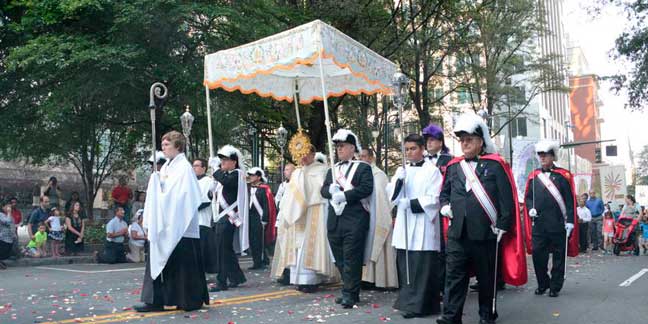 A strong faith in the Real Presence of Jesus Christ in the Eucharist is critical to a Catholic’s life, Bishop Peter Jugis said in his homily for the closing Mass of the 12th annual Eucharistic Congress.
A strong faith in the Real Presence of Jesus Christ in the Eucharist is critical to a Catholic’s life, Bishop Peter Jugis said in his homily for the closing Mass of the 12th annual Eucharistic Congress.
The Sept. 9-10, 2016, celebration at the Charlotte Convention Center drew approximately 15,000 people, organizers said – noticeably higher than the previous year’s attendance of 12,000-13,000 people. The event featured approximately 21 hours of continuous Eucharistic Adoration, a Eucharistic procession through uptown Charlotte that stretched for nearly a mile, and a two-hour closing liturgy that was standing-room-only in the convention center’s largest gathering space.
The theme of the 2016 congress – “Be merciful, just as your Father is merciful” – echoed the Church’s Extraordinary Jubilee Year of Mercy.
In his homily, Bishop Jugis encouraged Congress-goers to remember that Christ is truly present at every Eucharistic celebration, and the holy sacrifice of the Mass is the greatest sign of God’s mercy.
“Why do we have the Eucharistic Congress?” he asked. “We have a Eucharistic Congress because a strong and genuine Eucharistic faith means a strong and vibrant Church.”
3. Racial unrest, deaths rock Charlotte
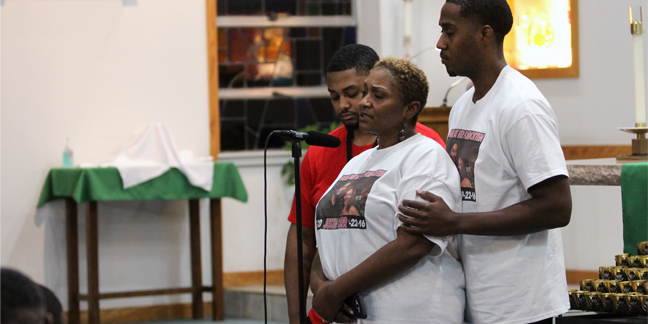 Charlotte erupted in protests for days following the fatal police shooting Sept. 20, 2016, of 43-year-old Keith Lamont Scott, an African-American, outside an apartment complex in north Charlotte.
Charlotte erupted in protests for days following the fatal police shooting Sept. 20, 2016, of 43-year-old Keith Lamont Scott, an African-American, outside an apartment complex in north Charlotte.
In response to the violence, Bishop Peter J. Jugis called on “the half-million Catholic men, women and children of the Diocese of Charlotte” to join him in prayers for “peace and justice” for all victims of violence and for law enforcement personnel who have been victims of “unjust violence.”
“Let us pray for all men and women of good will to be instruments of harmony and the always-shining light of Christ in our neighborhoods, workplaces, schools and public places,” he said.
At St. Thomas Aquinas Church, just a few blocks from the scene of the police shooting, about 150 people gathered to pray for peace Sept. 21. Father Patrick Winslow, pastor, offered prayers for police and for people who have suffered injustice, as well as prayers for his neighborhood and the city of Charlotte.
“In times such as these, it is good to recall that light shines in the darkness, and it must shine through you,” Father Winslow urged parishioners.
Referring to the Gospel according to St. John, Father Winslow said, “Retrospectively reflecting upon the events of Christ’s cross, His death and resurrection, he observes that the ‘light shines in the darkness and the darkness has not overcome it.’ This bold declaration refers to the triumph of the cross of Christ where the friction of human injustice set ablaze the Light of God in an otherwise dark world.”
“Since then,” he continued, “history has made it clear that the true battlefield upon which the light vanquishes that darkness is not between nations, it is not between races, nor is it in the streets of Charlotte or any U.S. city.
“The true battlefield is within the human heart – within each of us. This is where injustice must be defeated. This is where prejudice and unjust discrimination live. This is the place from which fear and darkness enter the world. And likewise, it is the place where it can be vanquished. I beg you, storm and loot your hearts, not the streets, if you want true change for the good. Vanquish the enemy within and then you will truly help your neighbor.”
Protests continued for a second night Sept. 21 in uptown Charlotte, about 10 miles away from the site of the shooting.
There, 26-year-old protester Justin Carr was shot and later died, several other people were injured, and a few businesses were vandalized and looted.
Carr’s death marked the most violent episode in the week of protests.
A special prayer service was held Sept. 23 at Our Lady of Consolation Church, where the Carr family has worshipped for three generations. It was organized by Father Carl Del Giudice, pastor, to give people a chance to share their feelings about the protests and the tragedy that had struck their parish family.
The dialogue continued in December with a special joint conversation on race, justice and understanding – “Charlotte Catholics: Our Stories in Black and White” – organized by Our Lady of Consolation and St. Peter churches. More than 200 people from 11 parishes participated in the four-hour event.
4. Diocese hosts first ‘blue Mass’
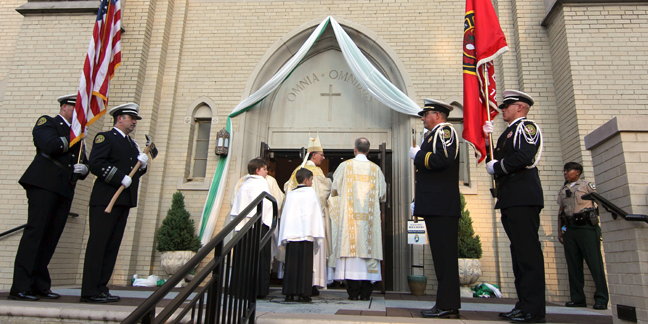 Father Winslow echoed his message about the battle between good and evil within the human heart during his homily at the diocese’s first “Blue Mass,” a liturgy held in honor of law enforcement and public safety personnel Sept. 29, 2016, at St. Patrick Cathedral in Charlotte.
Father Winslow echoed his message about the battle between good and evil within the human heart during his homily at the diocese’s first “Blue Mass,” a liturgy held in honor of law enforcement and public safety personnel Sept. 29, 2016, at St. Patrick Cathedral in Charlotte.
The Mass had been planned several weeks before the fatal police shooting Sept. 20 which triggered a week of protests in Charlotte that left two African- American men dead, several police officers injured, and residents shocked by the violence. The cathedral was filled with people who had come out to pray and express thanks to local first responders, during a liturgy offered on the Feast of the Archangels.
“We see a parallel between your work and theirs,” Father Winslow said. “We see the work you do as sharing in their angelic mission as protector, healer and aid to those in need.”
His parish, St. Thomas Aquinas Church, sits just a few blocks away from where Keith Lamont Scott was shot and killed by police. Protests erupted there on Sept. 20, and on Sept. 21 Father Winslow led one of the city’s first prayer services for reconciliation and justice.
5. Mother Teresa of Calcutta canonized
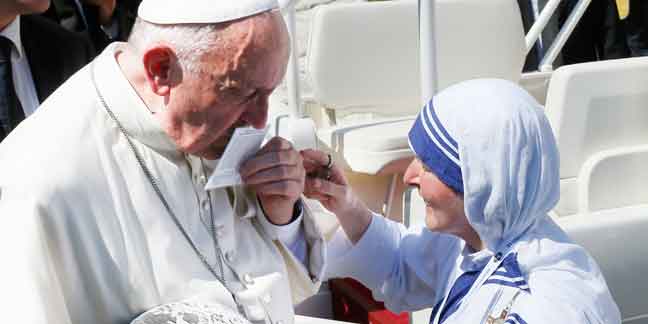 With a large tapestry bearing the portrait of the woman known as the “Saint of the Gutters” suspended above him, Pope Francis proclaimed the sainthood of Mother Teresa of Calcutta Sept. 4, 2016, hailing her courage and love for the poor.
With a large tapestry bearing the portrait of the woman known as the “Saint of the Gutters” suspended above him, Pope Francis proclaimed the sainthood of Mother Teresa of Calcutta Sept. 4, 2016, hailing her courage and love for the poor.
Despite the formality of the occasion though, “her sanctity is so close to us, so tender and fruitful, that spontaneously we will continue to call her ‘Mother Teresa,’” Pope Francis said to applause from 120,000 people attending the canonization Mass at St. Peter’s Basilica in Rome.
“Mother Teresa, in all aspects of her life, was a generous dispenser of divine mercy, making herself available for everyone through her welcome and defense of human life, those unborn and those abandoned and discarded,” the pope said.
Chas Fagan, a renowned American artist and parishioner of St. Peter Church, was the artist behind the image of the saint. The Knights of Columbus commissioned Fagan to create the official portrait.
Bishop Emeritus William Curlin, a longtime friend of Mother Teresa and her priest confessor, also spoke on numerous occasions about his memories of the saint and the lessons he drew from her ministry to the poor.
Mother Teresa’s ministry, the Missionaries of Charity, which now serves in more than 100 countries around the world, has a convent in east Charlotte where members of her order have cared for the poorest and most vulnerable for more than 20 years.
Mother Teresa herself visited Charlotte in 1995.
“She said that our life as Christians is not to lock Christ up inside, it’s to let Him out of us,” Bishop Curlin said.
“She actually believed when you woke up in the morning, God woke up in you. Through you, Jesus continues His works of mercy and love and reconciliation.”
Bishop Curlin said he will always remember her joy and her smile, both trademarks of her ministry.
“Her joy was a gift, one of the precious gifts we need in the world today,” he said.
6. Two ordained priests, five more ordained deacons
“You are priests of the Holy Year of Mercy. Shepherd the faithful with the mercy of Jesus,” Bishop Jugis told Father Cory Catron and Father David McCanless during their ordination Mass June 18, 2016, at St. Mark Church in Huntersville.
The two men were ordained for the Diocese of Charlotte during a two-hour Mass that drew hundreds of people, including dozens of priests and deacons, women religious, Knights of Columbus and lay faithful.
“God has looked with mercy on us in His Son Jesus, and wants you to be ministers of His mercy to extend His work of salvation in the world,” Bishop Jugis told Father Catron and Father McCanless. “You are priests of the Holy Year of Mercy. May the mercy of God show forth in your priestly ministry as you serve the Lord with joyful hearts.”
Earlier in June, Bishop Jugis also ordained Matthew Bean, Brian Becker, Christopher Bond and W. Christian Cook to the transitional diaconate. Peter Ascik was also ordained in late September in Rome.
7. Diocese opens St. Joseph College Seminary
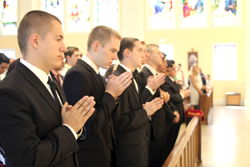 On March 19, 2016, the feast of St. Joseph, Bishop Peter J. Jugis formally announced the creation of St. Joseph College Seminary during the Bishop’s Lenten Youth Pilgrimage at Belmont Abbey College.
On March 19, 2016, the feast of St. Joseph, Bishop Peter J. Jugis formally announced the creation of St. Joseph College Seminary during the Bishop’s Lenten Youth Pilgrimage at Belmont Abbey College.
The Diocese of Charlotte established the college seminary in response to growing interest in priestly vocations. Eight men moved in to the college seminary, temporarily located on the campus of St. Ann Church in Charlotte, in August.
It is a “minor” seminary, as its focus is undergraduate men considering the priesthood, one step before enrolling in a “major” seminary where they receive more specific priestly formation. The seminary gives young men the opportunity to live closer to home, continue their college studies while in community together, and interact regularly with diocesan vocations staff.
“I think the faithful of the diocese will be greatly encouraged to know that as we are growing as a diocese, the Lord is answering their prayers and bringing forth vocations,” Bishop Jugis said.
8. Arden parish receives $3.6 million bequest
An unexpected windfall came to St. Barnabas Church in Arden through the generosity of a couple who quietly left the parish $3.6 million after their deaths. It is the single largest estate gift in the history of the Catholic Church in North Carolina.
Dennis Kushler and his wife Mary had been members of the Arden parish since retiring to the area in 2003.
Their endowment will provide the parish with an estimated $175,000 annual income initially, and it will grow over time.
9. Transgender bathroom policies stir controversy
The Obama administration’s directive on transgender access to bathrooms “that treats ‘a student’s gender identity as the student’s sex’ is deeply disturbing,” Bishop Jugis said May 18.
Bishop Jugis reiterated a joint statement from chairmen of two U.S. Catholic bishops’ committees, who said, “The guidance fails to address a number of important concerns and contradicts a basic understanding of human formation so well expressed by Pope Francis: that ‘the young need to be helped to accept their own body as it was created’ (“Amoris Laetitia,” 285).”
The administration’s action followed the Charlotte City Council’s move in February to enshrine rights of “gender expression” and “gender identity” in its anti-discrimination ordinance.
Religious leaders, business people and many city residents said they were alarmed at the ordinance which would have allowed, among other things, people to choose a public restroom or locker room corresponding to “gender identity” or “gender expression” rather than biological sex.
In response, state legislators passed legislation, House Bill 2, to override the city council’s ordinance. The bill also removed certain legal protections for same-sex attracted individuals, which sparked months of protests, economic boycotts and opposition from businesses and national sports leagues.
In December, the city council rescinded the ordinance under an understanding that the state legislature would also back down from H.B. 2, but as of press time legislators have not taken any action to do so.
10. Pope releases ‘Amoris Laetitia,’ exhortation on the family
In April, the Vatican released Pope Francis’ postsynodal apostolic exhortation on the family, “Amoris Laetitia” (“The Joy of Love”), insisting that God’s plan for the family is that it be built on the lifelong union of one man and one woman open to having children. The pope called for an overhaul of marriage preparation programs and for the prayerful accompaniment of Catholic couples whose marriages have failed.
The exhortation sprang from consultations with Catholics around the world and was discussed by the bishops at the 2014 and 2015 synods on the family, Pope Francis said.
Using “Amoris Laetitia” to affirm Church teaching on the indissolubility of marriage, Pope Francis wrote that because every situation is different, he would not provide new rules on ministry to the divorced and civilly remarried. However, he urged a new commitment on the part of pastors to provide spiritual guidance and assistance with discernment. A process of discernment, he has said, might eventually lead to a determination that access to the sacraments is possible.
That sparked some confusion. Four cardinals, including American Cardinal Raymond L. Burke, told the media they formally asked the pope to clarify his teaching on Communion for the divorced and civilly remarried.
When pressed on the question of the variety of interpretations given to “Amoris Laetitia,” Pope Francis has pointed people to Austrian Cardinal Christoph Schonborn of Vienna, whom the pope chose to present the document to the media.
No one has “a right to receive the Eucharist in an objective situation of sin,” the cardinal said, which is why the pope did not grant a blanket permission and insisted that civilly remarried people go through a whole process of discernment and repentance under the guidance of a priest. The discernment called for by the pope, he said, “takes greater account of those elements that suppress or attenuate imputability,” that is, moral responsibility, and seeks a path that would move a person closer to the fullness of what the Gospel demands.
Although not yet meeting the “objective ideal,” such couples would be helped to move closer to perfection, which, Cardinal Schonborn said, “is no small thing in the eyes of the Good Shepherd.”
— Patricia L. Guilfoyle, editor; and Catholic News Service
TAKE A LOOK BACK: MORE PHOTOS, VIDEOS AND STORIES ONLINE
At www.facebook.com/catholicnewsherald: Tell us: What was your favorite story of 2016?
At www.pinterest.com/charlottecnh: Read all these stories and see more photos and videos, all in one place, on our Year in Review board
Jubilarians
70 YEARS: Mercy Sister Mary Bernarda Hoff
60 YEARS: Mercy Sister Marian Joseph Baird
55 YEARS: Father Joseph Ayathupadam and Father James Cahill
50 YEARS: Father Albert Gondek, OSFS, and Mercy Sister Margaret Mary Wharton
40 YEARS: Father John D. Hoover
35 YEARS: Father James Byer, Father Francis Cancro, Father Carl Del Giudice, Father Jose Antonio Juya, Father Gnanapragasam Mariasoosai and Father James Turner, OSFS
30 YEARS: Deacon Patrick J. Devine, Deacon Jeffery S. Evers, Deacon H. Paul Herman and Deacon Dario Garcia Ospina
25 YEARS: Monsignor Anthony Marcaccio; Deacon Paul A. Liotard; and Missionary of Charity Sister Mary Flora and Missionary of Charity Sister Mary Magdela
20 YEARS: Father Fidel Melo and Deacon Lawrence P. O’Toole
15 YEARS: Father James Duc Duong, Father Tien Duong, Father Robert Ferris, Father Kurt Fohn, Father Adrian Porras and Father Christopher Roux; Deacon Kenneth L. Drummer, Deacon Scott D. Gilfillan, Deacon Pierre K’Briuh, Deacon David E. King, Deacon Alexander Lyerly, Deacon James J. Mazur, Deacon Mark D. Nash and Deacon Michael J. Zboyovski
10 YEARS: Father Alejandro Ayala and Father James Stuhrenberg; Deacon James L. Atkinson, Deacon David P. Boissey Sr., Deacon Mark S. Diener, Deacon Walter J. Haarsgaard, Deacon Edward A. Konarski Jr., Deacon John T. Kopfle, Deacon (Paul) Pee Lee, Deacon Lee T. Levenson, Deacon Larry G. Lisk, Deacon John A. Martino, Deacon Brian P. McNulty, Deacon Robert T. Murphy, Deacon A. Stephen Pickett, Deacon Michael L. Stout and Deacon Kevin B. Williams
5 YEARS: Father Joshua Voitus
Special anniversaries
- St. Benedict the Moor Church in Winston-Salem, 75 years
- Christ the King Church in High Point, 75 years
- St. Joseph Church in Bryson City, 75 years
- St. Frances of Rome Mission in Sparta, 50 years
- Our Lady of Guadalupe Mission in Cherokee, 50 years
- St. Matthew Church in Charlotte, 30 years
- Sisters of Mercy’s House of Mercy in Belmont (AIDS respite care), 25 years
- Catholic News Herald, 25 years
- St. Basil the Great Ukrainian Catholic Mission in Charlotte, 10 years
Building for growth
Besides the opening of St. Joseph College Seminary, 2016 saw several other building projects at parishes and schools:
- St. Pius X Church and School opened the DeJoy Primary Education Center (pictured above), which added a pre-kindergarten program to its K-8 school last fall, and a 23,000-square-foot Simmons Parish Life Center, which consolidates parish operations on the North Elm Street campus.
- June: A new Catholic cemetery was dedicated in Albemarle
- August: Holy Trinity Middle School campus completed a major overhaul
Sacraments
As of Dec. 31, 2016, in the diocese, there were:
- 6,369: Baptisms
- 5,826: First Holy Communions
- 4,354: Confirmations
- 994: Marriages
- 669: people received into the Church
Top stories online
In 2016, 122,742 visitors to www.catholicnewsherald.com viewed a total of 281,977 pages.
The 10 most popular stories last year were:
- 2016 priest assignments announced: 6,084
- Father Joe Mulligan to minister to Panthers at the Super Bowl: 5,425
- Carolina Panthers linebacker Luke Kuechly talks about his Catholic faith: 4,331
- Diocese announces college seminary for future priests: 3,363
- Catholic church near site of Charlotte protest prays for peace, justice: 3,632
- Tri-ritual priest reflects on his vocation, married life: 3,091
- Charlotte parish mourns death of young protester: 1,655
- Poor Clares of Perpetual Adoration announce merger of two communities: 1,649
- St. Matthew Church surpasses 10,000 registered families: 1,577
- St. Pius X School readies to open DeJoy Primary Education Center: 1,293
In memoriam
Mercy Sister Marianne Angert, who ministered at St. Joseph Hospital in Asheville and Mercy Hospital in Charlotte, died Feb. 26, 2016, aged 93. Professed with the Sisters of Mercy for 75 years, she also served as dean of students at Sacred Heart College in Belmont.
Augustinian Father John T. Denny, who served as pastor at St. Margaret of Scotland Church and Living Waters Retreat Center in Maggie Valley from 2007 until 2011, died June 20, 2016, aged 58.
Glenmary Father August “Gus” Guppenberger, who served as pastor at Holy Redeemer Church in Andrews from 1976 to 1986, died Nov. 6, 2016, aged 81.
Deacon Steve Horai, who served at Our Lady of the Assumption Church in Charlotte for almost 30 years, died July 11, 2016, aged 88.
Father Raymond B. Hourihan, who served as parochial vicar at St. Gabriel Church in Charlotte, parish administrator at Holy Infant Church in Reidsville, and as pastor of Our Lady of the Annunciation Church in Albemarle and St. John the Evangelist Church in Waynesville, died Oct. 11, 2016, aged 91.
Sister Mary Norman Joseph, CLHC, a member of the Maryvale Sisters, who served in various parishes at the Diocese of Charlotte, most recently at St. Aloysius Church in Hickory for 25 years as faith formation and adult education director, died Aug. 21, 2016, aged 69.
Capuchin Franciscan Father Stanislaus “Stan” W. Kobel, who served at St. Thomas Aquinas Church in Charlotte, died Nov. 12, 2016, aged 70.
Deacon Gerard (Jerry) Peter LaPointe Jr., who served at St. Margaret of Scotland Church in Maggie Valley for almost 16 years, died Dec. 18, 2016, aged 83.
Richard A. Lucey, who served as the general counsel for the Diocese of Charlotte beginning in 1992 until his retirement in Jan. 2016, died Oct. 2, 2016, aged 74.
Father Bernard A. Manley Jr., who served at St. Patrick Cathedral in Charlotte; as pastor of St. William Church in Murphy, Immaculate Heart of Mary Church in Hayesville and St. Francis of Assisi Church in Mocksville; and as priest in residence at St. Eugene Church in Asheville, died Nov. 3, 2016, aged 94.
Father Edmund McCaffrey, a retired priest of the Diocese of Charleston, who was a former Benedictine monk and former abbot of Belmont Abbey; founder and former head of the political science department at Belmont Abbey College, died Nov. 13, 2016, aged 83.
Kathryn “Katie” Christine Meseroll, who served at Sacred Heart School in Salisbury as a teacher, athletic director and assistant principal, and most recently served as principal of St. Michael School in Gastonia, died Sept. 8, 2016, aged 29.
Deacon Dennis Timothy O’ Madigan, who served at St. Leo the Great Church in Winston-Salem, died Jan. 31, 2016, aged 82.
Mercy Sister Joseph Marie Perez, professed for 69 years, died Nov. 6, 2016, aged 86.
Deacon Thomas Andrew Ramussen, Jr., who served at St. Joseph Church in Newton and St. Aloysius Church in Hickory, died Dec. 22, 2016, aged 72.
Sister Gretchen Reintjes, CSJ, passionate advocate for North Carolina’s refugees and immigrants and long-time Greensboro resident, died Jan. 22, 2016, aged 83.
Sister Francis Louise Sheridan of the Immaculate Heart of Mary, M.S.B.T., the first non-clergy director of the Diocese of Charlotte’s Catholic Charities agency, died Feb. 14, 2016, aged 85.
Father Andrew J. Vollkommer, who served at Belmont Abbey and St. Michael the Archangel Church in Gastonia from 1988 to 1993, died Jan. 27, 2016, aged 60.
Monsignor Thomas R. Walsh, who served as assistant pastor and pastor of 13 parishes across the coastal, Piedmont and mountain areas of North Carolina, including nine years as pastor of St. Gabriel Church in Charlotte, when the new church was built, died Dec. 2, 2016.
Mercy Sister Mary Timothy Warren, who served the Diocese of Charlotte in many ministries such as, teacher and principal of Catholic elementary schools in Charlotte and Asheville; pastoral associate at St. Gabriel Church in Charlotte; as well as developing and administering the Lay Ministry Program in the Diocese of Charlotte and Vicar for Women Religious in the Diocese, died July 11, 2016, aged 90.

















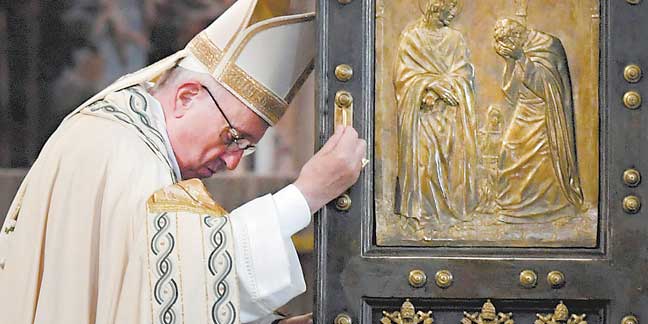 1. The Jubilee Year of Mercy: ‘Be merciful, just as the Father is merciful’
1. The Jubilee Year of Mercy: ‘Be merciful, just as the Father is merciful’